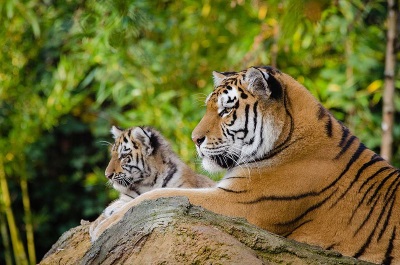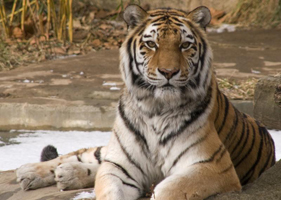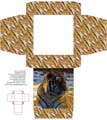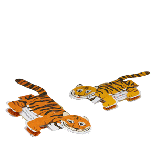Siberian Tiger -- School-age
There is only one species of tiger (Panthera tigris) but there are nine subspecies, three extinct and six living subspecies.
The Bali tiger, Javan tiger, and Caspian tiger are considered extinct today.
Six living subspecies:
Bengal tiger (Panthera tigris tigris)
Indo-Chinese tiger (Panthera tigris corbetti)
Malayan tiger (Panthera tigris. malayensis)
Siberian or Amur tiger (Panthera tigris altaica)
South China tiger (Panthera tigris. amoyensis)
Sumatran tiger (Panthera tigris sumatrae)
The Siberian tiger, also known as the Amur tiger, is the largest cat in the world. A male can weigh around 500 to 600 pounds or more and be nearly 11 feet (3.3 m) long. Males are larger than females.

Distribution and Habitat

Distribution of the Siberian tiger (in red)
Siberian tigers live in very cold areas. They roam the forests with ground often covered in snow. Their large paws act like snowshoes, which keeps the Siberian tiger from sinking into the snow. A male's front paws can be six to eight inches (15-20cm) wide and over seven inches (17 cm)long. The pads on the Siberian tigers feet allows it to walk silently.

Body
The Siberian tigers body is covered in thick, long fur, that keeps it warm. During the winter, its fur grows thicker and longer to help keep it warm. Siberian tigers are distinguishable by their striped fur. No two tigers have the same stripped pattern. They use their striped coats as camouflage, it is difficult to see them in the forest.

Siberian tigers are rusty-red or rusty-yellow with dark brown stripes, they have white fur on their face, underbelly, and paws. It has yellow irises and round pupils in its eyes. It hunts mainly at night and relies on its excellent night vision, which is 6 times better than that of a human.
Video
Behavior
The Siberian tiger is a mammal. It mainly lives alone and is highly territorial. A male may share its territory with females but not other males. Siberian tigers can mate at any time of the year. It takes about 110 days for a young cub to be born. The female can give birth to a litter of 2 to 4 cubs. The cubs are born blind and defenseless, they need their mother to protect and feed them.

Siberian tigers can run at speed of 50 miles per hour (80.47 km/h ). However they can maintain that speed for only a short time. Siberian tigers can climb trees, especially when they are young but as an adult their size makes climbing difficult. Siberian tigers are considered superb swimmers and they often hunt in water.
Video
Diet
Siberian tigers are carnivores (meat eaters) and are at the top of the food chain. They are powerful making them excellent hunters. They have powerful jaws and like other cats like to sneak up and pounce on their prey. A hungry Siberian tiger can eat up to 60 pounds in one night.
Siberian tigers diet consist of small prey and large prey. Deer and wild boar is its many food. It will also feed upon lynx and bear. It will also feed on smaller prey such as fish and rabbits.
Siberian tigers eat wild boars, deer, water buffalo, moose, gazelle, hares, rabbits, musk deer, lynx and jackals. However, its main diet consists of wild boar. They also sometimes hunt birds and fish such as salmon.
Recommended Book
Tiger Math: Learning to Graph from a Baby Tiger
by Ann Whitehead Nagda
Children learn to graph as they follow the growth of an orphaned Siberian tiger cub.
A Siberian tiger cub born at the Denver Zoo is orphaned when he is just a few weeks old. At first T. J. refuses to eat his new food, and it requires the full attention of the zoo staff to ensure that he grows into a huge, beautiful, and very healthy tiger.
Children follow T.J. as he grows with wonderful photographs, graphs, and narrative. Students love this book!
Make
Download patterns and instructions to make the Snap Ups Tiger. This is a fun paper craft of a cute tiger, that springs up into the air. Push the tiger's body from the side to make him flat, hold him down with your finger, then quickly let go and watch how the rubber band makes him jump!
Sites to See








